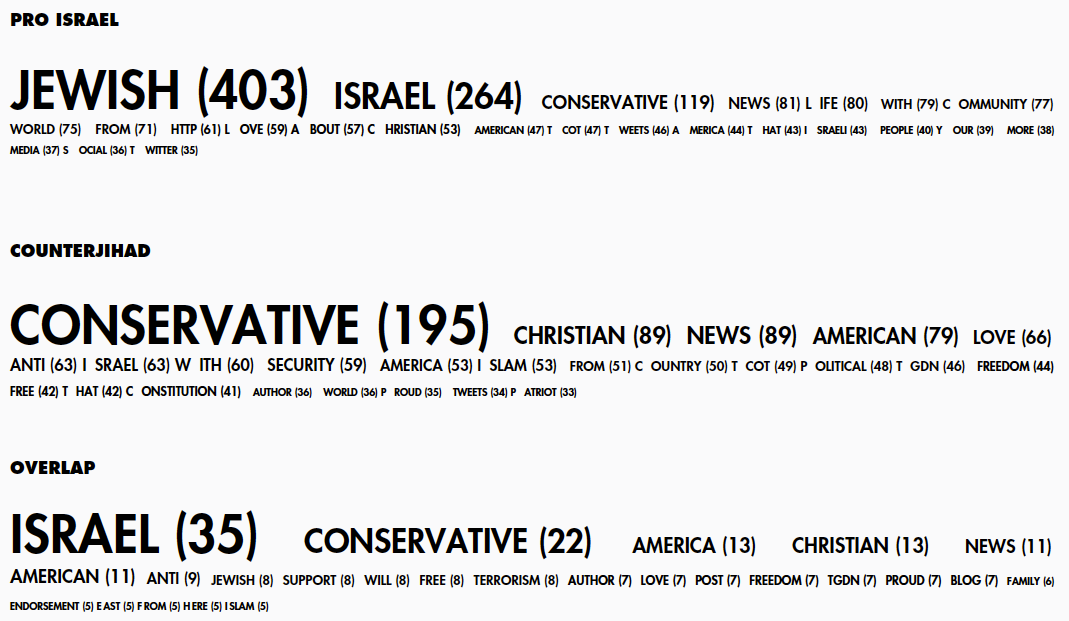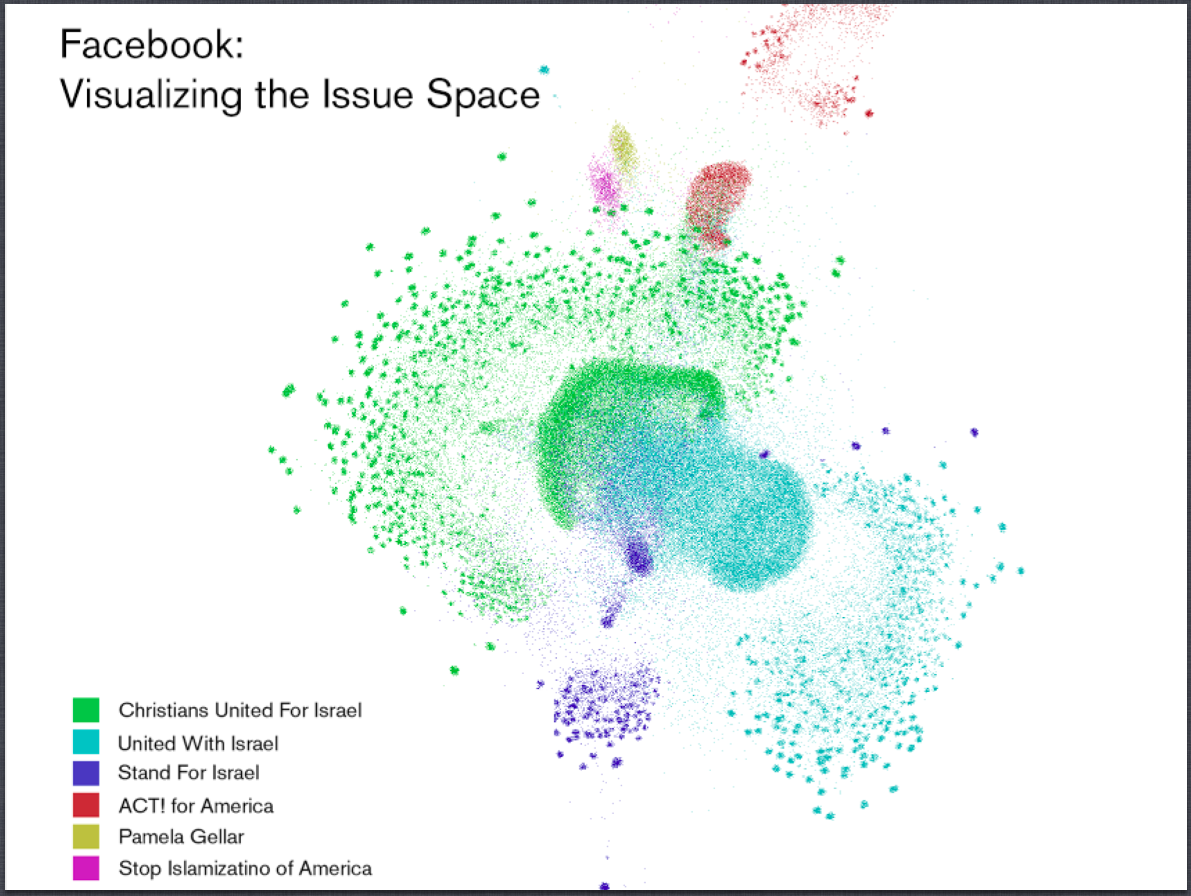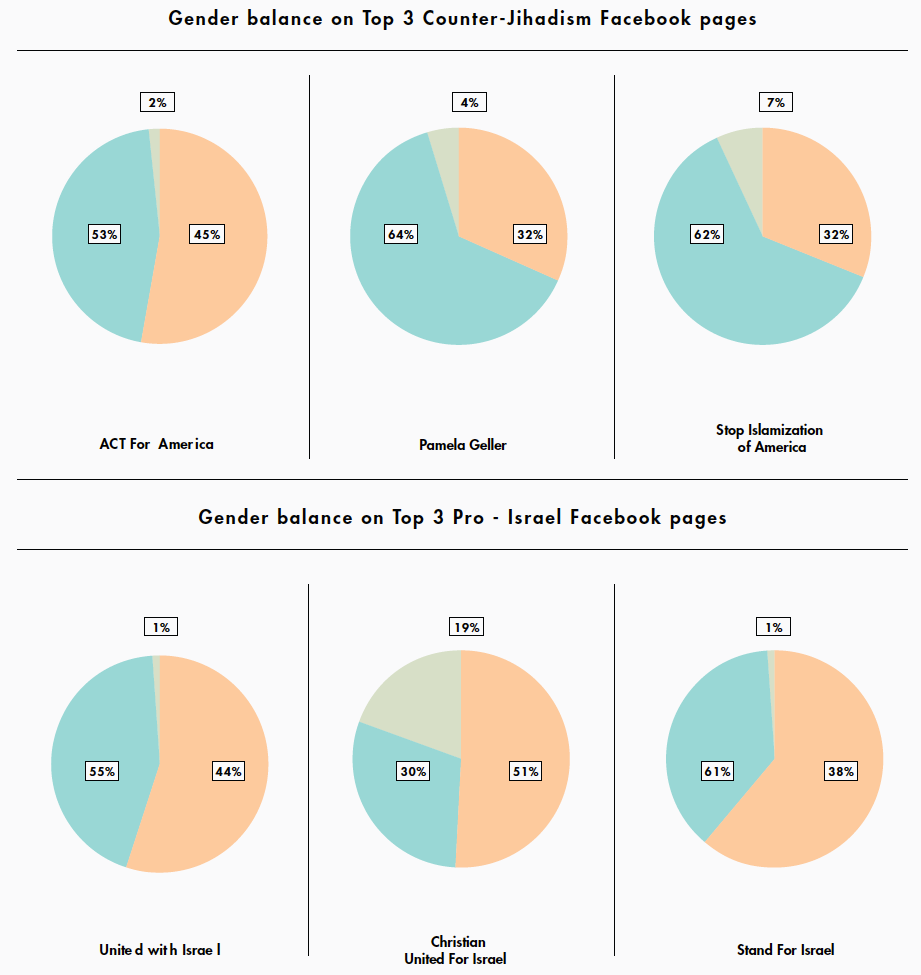My Enemys Enemys My Friend: Mapping & Comparing Counter-Jihad and Pro-Israel Support on Social Networks
Basri Hoogstrate, Maya Livio, Jules Mataly, Mathias SchuhIntroduction
This project seeks to make contributions to our understanding of the counter-jihad movements support base through its comparison with an issue space that has been claimed to be related. Specifically, the project group sought to analyse the potential overlap of the pro-Israel and counter-jihad spaces on Facebook and Twitter. The project idea was initiated by claims that pro-Israel supporters and counter-jihadists share a common political ground, and research into the rhetoric of European and American counter-jihadists that proves such claims. User engagement with content on relevant Facebook pages, as well as user-curated lists of relevant Twitter channels were the main sources for research, and were analysed using a series of digital methods and tools over the course of the data sprint week.
While the agenda of the various European counter-jihadist groups and networks is coherent with regards to their opposition of Islam, their positions towards other political issues are not always clear. This is evident in the ideology surrounding the political parties of the European New Right (ENR), where positions are oftentimes conflicting, particularly when it comes to the intersection between pro-Israel support and anti-semitism. Overall, it has been claimed that the European counter-jihadism movement is in support of Israel, as exemplified by anti-Palestinian protests organised by the English Defence League (EDL). The EDL even has a declared Jewish chapter, called the Jewish Defence League. At the same time however, counter-jihadist networks such as the EDL attract nationalist, anti-semitic groups and parties. Similarly, Anders Breiviks manifesto contains pro-Israel sentiments, while one of the defence witnesses in his court case is a member of an anti-semitic Norwegian group. This illustrates how the European counter-jihadism movement does not necessarily have a coherent position towards anti-semitism at this point in time.1
In the United States however, counter-jihad and pro-Israel sentiments appear much more unified. Drawing from pre-9/11 concepts such as Samuel Huntingtons clash of civilisations or Bernhard Lewiss Muslim rage, some of the recent counter-jihad frameworks have put Israel at the very front of the alleged clash between Western and Islamic civilisation. The narrative created thus suggests that the defence of the Israeli statehood and its control over the occupied territories are key to the prevention of an Islamic threat.2 This idea has been taken to a political level by groups such as AIPAC, the American-Israeli Public Affairs Committee, or numerous Christian zionist groups, who strive to give greater visibilities to their agenda by means of virtually uncontested political lobbying.3 Yet political advocacy groups do not stand as much at the epicentre of the present-day American counter-jihad movement as a network of writers and authors whose key tools in political mobilization include blogs, social media profiles and books. Arguably the most prominent figure within this network is conservative author Pamela Geller, editor of the anti-Islamic website Atlas Shrugs and one of the leaders of the organisation Stop Islamization of America (SIOA). Even though the rejection of Islam is at the very center of Gellers activities, pro-Israel rhetoric plays a crucial role in her writing.4
Against this backdrop, this study was founded on the question of how these two issue spacescounter-jihadism and pro-Israel supportare intertwined, and how this overlap can be made visible on social media platforms. This study examined user activity on relevant Facebook Fan Pages from both issue spaces, as well as followership of important Twitter accounts for either of the causes in order to highlight the commonalities and differences between these two spheres. The geographical scope of this research was limited to the United States, under the assumption that both issue spaces were represented with a considerable amount of active users there.
Methodology
Research was carried out on both Facebook and Twitter, with particular focus on the followership and user activity in each of the two aforementioned issue spaces as well as in the overlapping space between them. In order to obtain user and user activity data, the first step was to map these issue spaces, using different approaches for Twitter and Facebook.
The user data collection was then further refined in two steps: First, we generated a list of unique usernames for each issue space and subsequently employed the DMI Triangulator tool to see how many users were represented on both lists, i.e. in both issue spaces. Second, we collected all of the self-made biographies of the users in order to identify the popular keywords used by users in each issue space in order to characterise the average user in the overlapping space.
The analysis of these spheres on Facebook followed a similar approach, beginning with mapping the two issue spaces and generating a shortlist of relevant Facebook Fan Pages, then subsequently analysing the user engagement with the content posted on these Pages by the their Administrators.
Our first step was to create a number of Facebook profiles for research purposes. The reason for this was that the sampling process greatly depended on automatically generated page suggestions by Facebook, which will be explained further down, and we wanted to avoid a distortion of these results by our personal page likes. Using freshly generated research profiles, we started to like relevant pages in both of the issue space. Akin to the Twitter research, the starting point for this were pages of prominent personalities or organisations as found in claims like the aforementioned. In the next stage, we queried Facebooks built-in search function with relevant queries such as USA, Jihad, or Israel, and added the relevant pages with the largest fan base to our list of liked pages. Additionally, we browsed the pages liked by the most prominent pages (Facebooks functionality allows not only users, but also pages to like other fan pages to express their endorsement). Finally, Facebooks automatic suggestions to like new pages, which is based on pages, groups or content the user has previously engaged with, were analysed and, if relevant, some of the suggested pages were added to the list.
Having thus curated two distinct Facebook networks in the spheres of pro-Israeli attitudes and counter-jihad sentiments, we sorted the list by number of fans and chose the three most popular pages of each issue space (i.e. six fan pages in total). At the time of research, the most popular pages in the counter-jihad issue space were:
- ACT! For America (39,929 likes)
- Pamela Geller (14,862 likes)
- Stop Islamization of America (10,199 likes)
Similarly, the biggest pages by number of likes in the Pro-Israel space at time of research were:
- United with Israel (1,560,710 likes)
- Christians United for Israel (1,012,832 likes)
- Stand for Israel (314,204 likes)
Our research interest revolved largely around user engagement with page content, that is, the likes, comments and shares of content items posted by the page administrators. In order to obtain this data, we downloaded the publicly available data of all the users who engaged with any of the 999 recent content items posted on either of the six pages. This was done using the DMI Netvizz application, which aggregates and outputs the data in the form of a .gdf file.
The analysis of this data was carried out in two steps. Firstly, the .gdf data sets were opened with Gephi in order to visualise the data and get an overview of user activity and engagement. This step was done for each page individually in order to highlight the relation between users and content types. The Gephi application rendered the retrieved data into a network, in which posts (content) are displayed as hubs and interactions (users) as nodes clustered around them. The visualisation was then customised with Gephis built-in tools, as follows: The most engaged with content and the most active users were made stand out as larger hubs and nodes, while the different content types (links, photo, status, video) were colour-coded. As a next step, the three data sets of each issue spaces were merged to visualise the overlap between these pages and to make visible which users are active in more than one group. Finally, the combined user lists for each of the two issue spaces were merged into one visualisation, enabling us to make visible how and to what extent they overlap.
Moreover, user data was extracted from .gdf files and further processed. Using the unique user IDs, we were able to compile a list of recently active users for each of the six pages. These lists were then triangulated using the DMI Triangulation tool, which detects shared list items of two or more lists. This made it possible to measure how many users were active on multiple pages within one issue space. Again, the next step was to merge the user lists in order to retrieve one Pro-Israel and one counter-jihad supporter list. These two lists were then triangulated too. Additional user data scraped by the Netvizz application was also analysed, allowing us to also analyse the sex of the users active on all of the six pages.
Findings
As described above, our research on Twitter sought to examine the overlap between the Pro-Israel and the counter-jihad issue space, represented by a sample of approximately 1,100 users each. By scraping and analysing this user data, we found out that about 11% of the users in the sample were represented on lists in both issue spaces and thus being labeled as both Pro-Israel and counter-jihad by the Twitter community.
A closer examination of the users represented in both issues spaces as well as in the overlapping space was carried out by means of collecting and analysing the short biographies used by the users to describe themselves on their Twitter pages. The collected biography texts were analysed in terms of word frequency in order to determine patterns in the users communicated identities.
In the Pro-Israel community, the terms Jewish, Israel and conservative were the most frequently used words in the self-descriptions. Users in the counter-jihad issue space most commonly used conservative, Christian and American. Finally, in the overlapping sphere of Pro-Israel and counter-jihad users, the top keywords were Israel, conservative Christian and America.

The analysis of our sample of six Facebook pages was carried out on multiple levels. We first looked at the user-content-interaction for each page individually, and secondly merged them into issues spaces to see how the spheres of Pro-Israel and counter-jihad activity overlap. Finally, we looked into the gender balance of users engaging with content on either of the pages.
For the individual page analysis, we found that user engagement on the ACT! For America page, the largest page in the counter-jihad issue space, appears to be divided into two userships according to content type: While a larger portion of users mostly engage with photos posted on the pages wall, a smaller group clusters around regular status updates or links. The other two counter-jihad pages, Pamela Geller and SIOA, primarily post links and, which results in a more coherent user engagement. On both pages however, a core followership of no more than ten users is engaging to a significantly higher degree than the other users. In the Pro-Israel issue space, user engagement on the United with Israel and Christians United for Israel pages show a similar distribution. A division between engagement with photos and with other content types, akin to the one described above, is clearly visible, with specific photos attracting particularly high levels of user interest. Stand for Israel shows a more homogenous distribution of user engagement, with photos attracting slightly more overall attention.

An analysis of the overlap of user activity in the Pro-Israel and the counter-jihad issue space showed that the shared user space of both movements amounts to 1.27%. A visualisation of this overlap moreover shows that this overlap largely occurs between the communities of ACT! For America and Christians United for Israel, the two largest groups in each issue space.
However, it needs to be mentioned that the Pro-Israel issue space was significantly larger in terms of user engagement. In order to take this disproportion into account and further nuance our findings, we looked at the overlap from the perspective of the issue spaces separately. This showed us that only 1.32% of users in the Pro-Israeli issue space also support counter-jihadist pages, as many as 25% of counter-jihad supporters are also following Pro-Israel groups.

The analysis of gender balance
In terms of gender balance, both issue spaces appear to attract more female than male users. The only exception to this rule is the page Pamela Geller, which has more male fans. However it needs to be mentioned that not all users disclose information about their sex on their public profile. For this reason, a third category had to be defined to account for users who do not indicate their gender. While the share of these users in the Pro-Israel space is relatively low, significantly more users in the counter-jihad issue space do not provide information about their sex on their public profile. For users active on the Stop Islamisation of America page, this number is particularly high and amounts to nearly half the number of users.
Conclusion
The approach taken in this study sets out with the claim that counter-jihadism is not to be regarded as an entirely monothematic political cause, but intertwines with other political issues. Previous research has shown that the political agendas and the rhetoric of counter-jihadists also contain Pro-Israel support to varying degrees. There is, however, a difference between the European discourse, where Pro-Israel sentiments compete with right-wing anti-semitic causes, and the American counter-jihadism, where the rejection of Islam and the support of the Israeli statehood appear to go hand in hand. In this study, we have taken a closer look at the overlap between counter-jihad and Pro-Israel voices in the United States by analysing user engagement with relevant content on Facebook and Twitter.
The analysis of the three biggest Facebook pages in each the counter-jihad and the Pro-Israel issue sphere shows that just over one percent of Pro-Israel supporters also back the agenda of counter-jihadists, whereas a quarter of users who engage with counter-jihad content also support Pro-Israel sites. On Twitter, where the popularity of users was determined by analysing user-curated lists they are featured on, the overlap amounts to approximately 11 percent.
In terms of the content types users engage with, the Facebook analysis shows that different types of content posted by the page administrators can attract entirely different audiences. Some of the analysed pages show a significant divide between users who engage with links or regular status updates, and users who like, share or comment on photos.
The analysis of user profiles, based on the information available in the public profiles of the users, showed that both the Pro-Israel and the counter-jihad issue space in general attract more female than male users. The aggregated self-descriptions of users meanwhile revealed that the majority of users active in both discourses would use labels such as conservative and Christian to classify themselves, and also points at strong Pro-Israel sentiments.
Overall, the methodology employed for this research allows to be used in a variety of other ways to carry out future research in the field of counter-jihadism. Building onto our findings, a closer analysis of the networks could help to determine key players and opinion leaders in both issue spaces. Moreover, the most engaged with content could be the object of further research. Finally, the profiling of users, which in this study was limited to gender and self-descriptions, could also be taken further in order to highlight other shared political issues that may overlap with the agenda of American or European counter-jihadists.References
1 Chetan Bhatt, The New Xenologies of Europe: Civil Tensions and Mythic Pasts, Journal of Civil Society 8.3 (2012): 311.
2 Liz Fekete, The Muslim conspiracy theory and the Oslo massacre, Race and Class 53.3 (2012): 42.
3 John Mearsheimer and Stephen Walt, The Israel Lobby and U.S. Foreign Policy, Middle East Policy 13.3 (2006): 62.
4 Anna Barnard and Alan Feuer, Outraged, and Outrageous, 8 October 2010, The New York Times, 10 March 2013 <http://www.nytimes.com/2010/10/10/nyregion/10geller.html>.
5 Shaomei et al, Who Says What to Whom on Twitter, Proceedings of WWW 2011, 28 March 1 April 2011, Hyderabad, India, 707.
| I | Attachment | Action | Size | Date | Who | Comment |
|---|---|---|---|---|---|---|
| |
gender_balance.png | manage | 76 K | 06 Sep 2013 - 13:59 | MathiasSchuh | Gender balance per Facebook group |
| |
issue_space_overlap_graph.png | manage | 658 K | 06 Sep 2013 - 13:56 | MathiasSchuh | Visualisation of the issue space overlap on Facebook |
| |
overlap.png | manage | 39 K | 06 Sep 2013 - 13:51 | MathiasSchuh | Issue space overlap on Facebook and Twitter |
| |
self_descriptions.png | manage | 144 K | 06 Sep 2013 - 13:52 | MathiasSchuh | Most common keywords in Twitter users' self-descriptions |
 Copyright © by the contributing authors. All material on this collaboration platform is the property of the contributing authors.
Copyright © by the contributing authors. All material on this collaboration platform is the property of the contributing authors. Ideas, requests, problems regarding Foswiki? Send feedback


